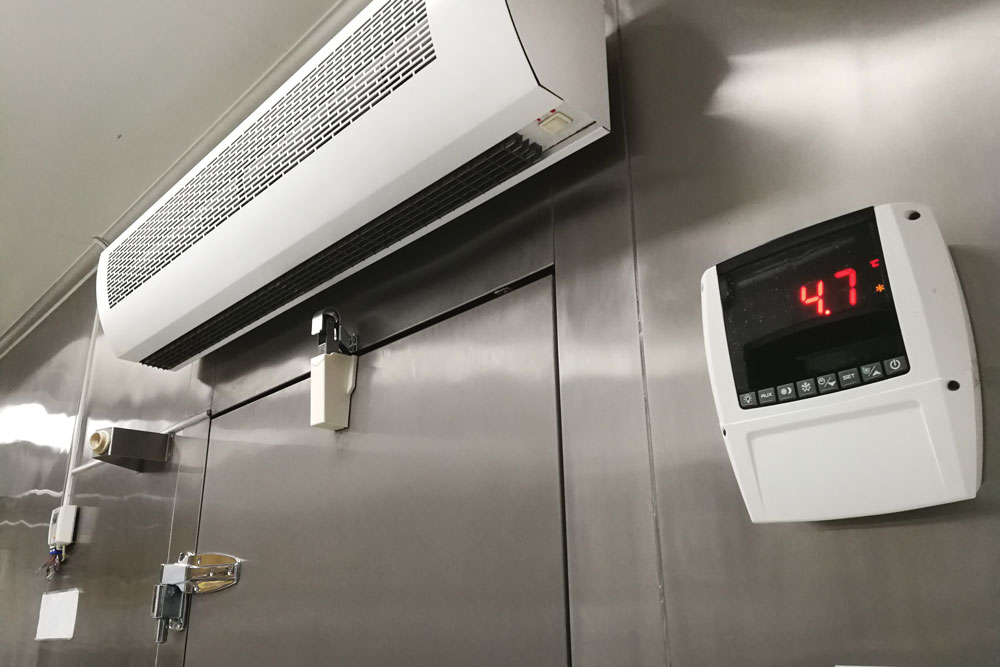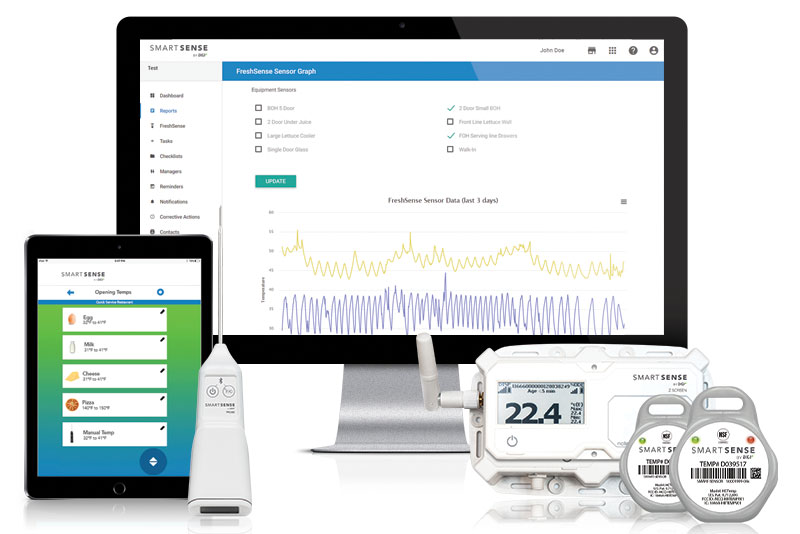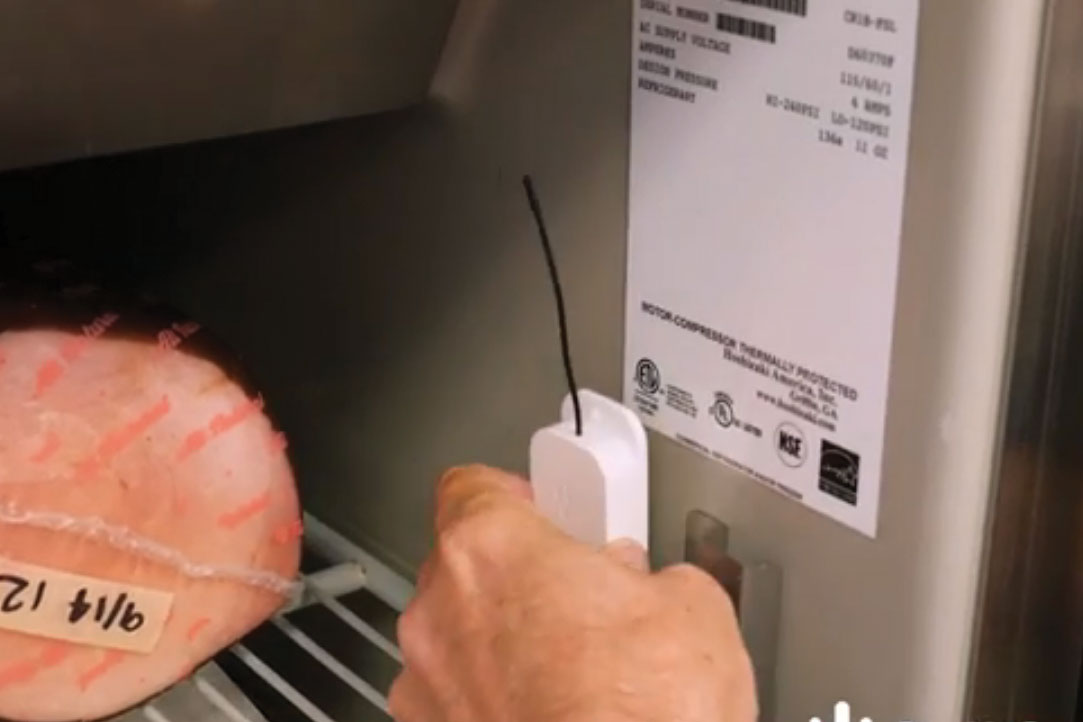As with all appliances, restaurant refrigeration technology is quickly moving fridges and freezers into the Jetsons era with added features, from cloud-based monitoring to WiFi capabilities. “The latest innovations in smart fridges and freezers include touchscreens, and we’re seeing a strong emphasis on built-in cameras as well,” says Beverly Friedmann, content manager for MyFoodSubscriptions in New York City. “With these latest technologies and advancements, pizzeria operators are experiencing great benefits. Instead of requiring manual labor, everything is becoming streamlined and automated—and the increase in automation is expediting efficiency, which in turn leads to increased revenue.”

Restaurant refrigeration technology is getting smarter every day. (Getty Images)
Techie Touches
Jeff Rieger, director of foodservice solutions at Boston-based SmartSense by Digi, notes that recent improvements in refrigeration center around the increasing accessibility of technology. “The prominent theme now is Internet of Things (IoT), which is a general idea that things not previously connected are now able to reach the cloud, the internet or the smartphone, making that information easily accessible from anywhere in the world,” Rieger explains. “Previously, you’d have to physically be on-site, but in the last decade, it’s more affordable to integrate technology into items like refrigerators.”
Related: Boost your bottom line with energy-efficient restaurant refrigeration equipment
Though newer models may have features like built-in WiFi connection and touchscreens, retrofitting an older model is also possible: A battery-operated sensor placed in an existing fridge relates the info online through a web dashboard, allowing operators to easily see and analyze pertinent info. “There is now also the NB-IoT (Narrowband Internet of Things), a low-powered cellular network that significantly reduces the cost and complexity of setting up one of these systems,” Rieger adds. “Sensors can be connected inexpensively and reliably; while still in its infancy, it would significantly ease the burden of setting up a system like this. You can even have cameras to monitor what’s on the shelves, though that’s still in its early days, too.”
“The latest tech-savvy upgrades can be especially helpful for small pizzeria operators, from communicating with employees to having voice assistants help with minor or tedious tasks.”
— Jason Martinez, Howard’s Appliance, TV & Mattress

Photo courtesy SmartSense
Similarly, VEN-U, a brand of Long Range Systems, headquartered in Richardson, Texas, recently launched a wireless sensor platform that can work with and monitor existing refrigerators and freezers as well as ovens, prep tables and heated display boxes. “Small, wireless sensors are connected via WiFi to a bridge that constantly uploads monitoring information to the cloud,” explains David M. Burrows, VEN-U head of marketing. “Any changes in temperature, outside of preselected thresholds, instantly sends an SMS text to staff for immediate attention and response.” Sensor thresholds can also be set for multiple times, and the system can store recorded data for up to two weeks—even if not connected to the cloud via WiFi.
Even better, this type of high-tech monitoring can go beyond temperature alone. For example, sensors can report on humidity, water presence, vibration, a change in lighting, sensing specific gases, weight, change in voltage, and any type of motion. “The sensors operate 24/7 and can tie into different dashboards for real-time monitoring and analyzing trends over time,” Burrows explains.
“Instead of requiring manual labor, everything is becoming streamlined and automated—and the increase in automation is expediting efficiency, which in turn leads to increased revenue.”
— Beverly Friedmann, MyFoodSubscriptions

Photo courtesy Ven-U
Operator Benefits
So what do these advances in restaurant refrigeration technology mean for operators? Jason Martinez, an employee at Howard’s Appliance TV & Mattress, with 12 locations in California, points to a slew of productivity-boosting features. “You can post important memos or notes for others to see, and you can leverage the power of voice assistants like Bixby,” Martinez explains. “The latest tech-savvy upgrades can be especially helpful for small pizzeria operators, from communicating with employees to having voice assistants help with minor or tedious tasks.” Meanwhile, built-in cameras can help monitor food inventory and minimize theft, while streaming music service and customizable screen savers can be used to motivate or inform back-of-house staff.
Related: Tips for maintaining your restaurant’s freezers and refrigerators
Rieger adds that remote temperature monitoring helps pizzerias ensure food quality, prevent spoilage and ensure inspection compliance. “Restaurant managers report that constant remote monitoring gives them the peace of mind knowing ‘someone’ is watching the store during peak service times, or when it’s after-hours and no one is present,” Rieger says. “Refrigeration and freezer temperature monitoring also provides users analytics and insights, which allow you to learn from previous data.”
Burrows agrees that wireless, remote and automated temperature monitoring saves staff time on checking fridges manually, can reduce costs by saving perishable inventory, increases food safety, and affords operators the ability to compare data over time to optimize operations and lower costs. “For the near future, we see additional technology features being added for customizable dashboards to monitor any item, via the IoT, in the front or back of the house,” Burrows predicts. “That offers the ability to set multiple thresholds of changes for different staff to respond to at different times.”
Finally, Rieger, whose company’s clients include Pizza Ranch and other big-name pizza brands, advises working with a company that handles the heavy lifting and follow-through: retrofitting your current equipment via installation, providing data reports, and ensuring proper functioning of the equipment. “They can even provide operators advice on what equipment to buy,” Rieger says. “For example, we have a few customers with thousands of units but different varieties of refrigeration, so we can score each piece of equipment and project longevity and stability of operation for each model. A data science team can work on predictive modeling for refrigeration equipment—and the more data, the better models for predicting.” For example, using this data, a company can predict, based on the past six months, how the equipment will perform over the next six months—or if it will fail altogether, thus recommending predictive maintenance or looking for a new (possibly tech-savvy) model.
Tracy Morin is PMQ’s senior copy editor.
Restaurant Refrigeration: Keeping Your Cool
To help pizzeria owners save money over the long term, Energy Upgrade California shares some simple, cost-effective solutions to maximize the capability of any refrigerator, including the smart and not-so-smart options:
Location, location, location. Locating refrigerators away from heat-generating units considerably lowers the amount of energy required to cool off and ensures they aren’t working harder than they need to be. Also consider installing or moving walk-in refrigerators and freezers so they aren’t wedged in tight spots, allowing for better air circulation and consuming less energy.
Manage temperatures. Maintain appropriate temperature settings in freezers (-14°F to -8°F) and refrigerators (35°F to 38°F) to save energy and ensure an effective chill.
Beware worn gaskets. Replace worn seals and gaskets on refrigerator and freezer doors to eliminate cold air from sneaking out and lowering energy efficiency.
Get charged up. Make sure to check your refrigerant charge. Using the wrong refrigerant can lead to unwanted effects, such as high power consumption when walk-ins have too little refrigerant.
Avoid door heaters. Unless there is significant frost on the door or water dripping on the floor, it may be unnecessary to leave the door heater on.













